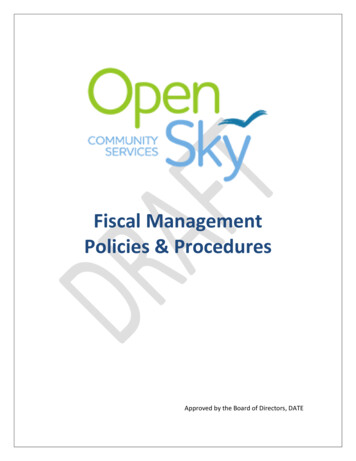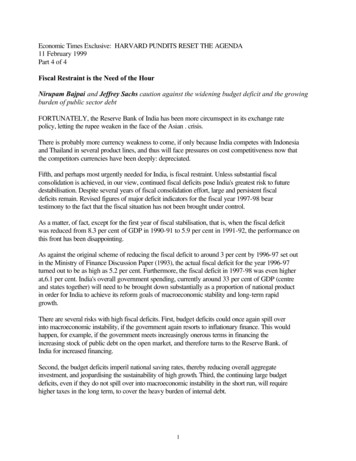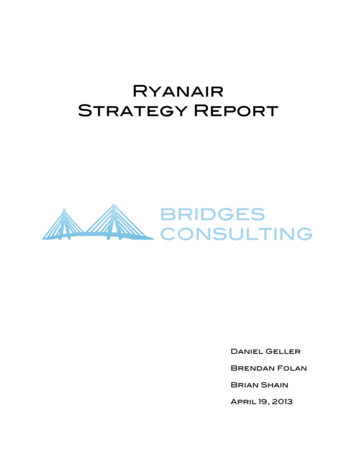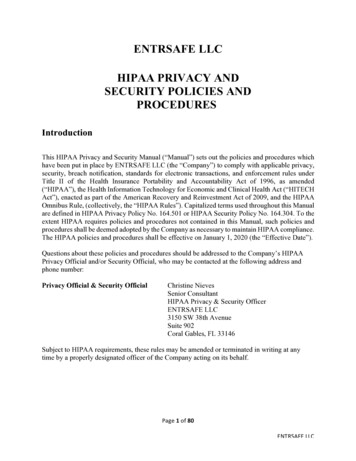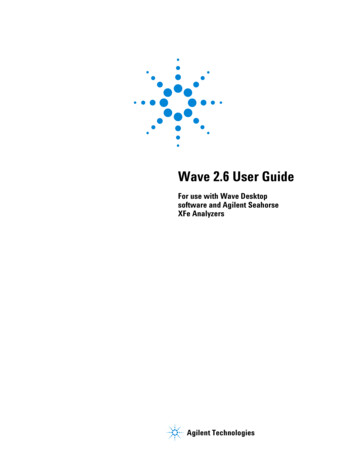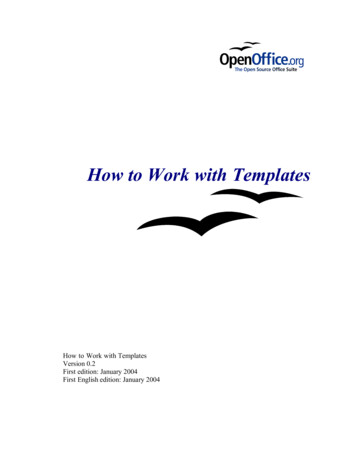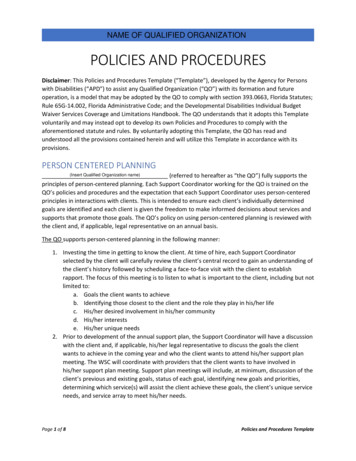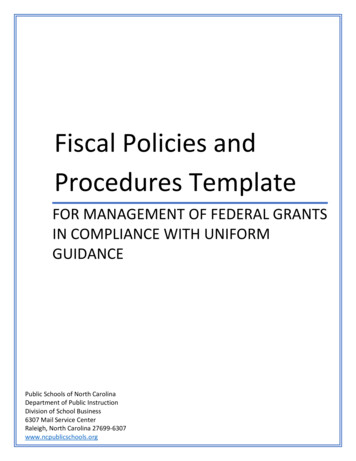
Transcription
Fiscal Policies andProcedures TemplateFOR MANAGEMENT OF FEDERAL GRANTSIN COMPLIANCE WITH UNIFORMGUIDANCEPublic Schools of North CarolinaDepartment of Public InstructionDivision of School Business6307 Mail Service CenterRaleigh, North Carolina 27699-6307www.ncpublicschools.org
In compliance with federal law, including the provisions of Title IX of the Education Amendments of 1972,the North Carolina Department of Public Instruction does not discriminate on the basis of race, sex, religion,color, national or ethnic origin, age, disability, or military service in its policies, programs activities,admissions or employment.
On December 19, 2014 the US Department of Education (ED) released the newly updatedEducation Department General Administrative Regulations (EDGAR). This change was due tothe Office of Management and Budget’s (OMB) publications of the final UniformAdministrative Requirements, Cost Principles and Audit Requirements for Federal Awards(known as the Uniform Grant Guidance or UGG), which consolidated OMB circulars a-21, A87, A-102 and A-122, A-133 into a uniform set of rules.Pursuant to EDGAR, some of the policies and procedures MUST be in writing: Procurement (2C.F.R. § 200.318), Cash Management (2 C.F.R. § 200.302 (6) and Allowable Costs (2 C.F.R. §200.302 (7)).This template provides the framework for creating policies and procedures related to theadministration of federal education programs. Specifically, it contains the internal controls andgrant management standards non-federal entities must use to ensure that all federal funds arelawfully expended. It describes in detail: financial management standards, including appropriatecash management procedures; allowability rules; procurement policies; property managementprotocols; and record retention requirements.This document is designed to serve as a template for an entity to use when developing its ownpolicies and procedures. This template does not include all compliance requirements and ismeant to be a starting point and a reference guide for Local Education Agencies (LEA’s) as theybegin to draft policies and procedures that are unique to the specific circumstances of theirorganization. It includes questions to ask and issues to consider.DisclaimerThis template was adapted, with permission, from the Brustein & Manasevit, PLLC. Thistemplate is provided to you as a resource document. It does not constitute legal advice.Please contact your legal representative for counsel.
TABLE OF CONTENTSUpdate/Insert when manual is finalized]Most Frequently Asked Questions . 3Question: What is the difference between Policies and Procedures? . 3Question: How do we know which sections require written procedures and which sectionsrequire written policies? . 3Introduction and Overview . 4Financial Management System Procedures . 5Determining Allowability of Costs Procedures . 9Timely Obligation of Funds . 17When Obligations are Made . 17Period of Performance of Federal Funds . 17Carryover . 19Program Income . 21Procurement System Procedures The LEA maintains the following purchasing procedures . 22Property Management Systems Procedures . 32Written Compensation Policies. 35A.Time and Effort . 35Time and Effort Standards . 35Example 2: Written Time and Effort Procedures for LEA#XXX . 38Record Keeping . 461
2
Most Frequently Asked QuestionsQuestion: What is the difference between Policies and Procedures?Answer: Policies goals. Policies are formal guidance for your LEA and may require anadoption by a school board or other governing body.Procedures steps that ensure goals are met. The procedures are simply written fiscalsteps/processes to achieve your LEA’s goals. Changes in procedures must be internallyreviewed by the appropriate staff. Written procedures (as well as policies) are anevidence of compliance under all program monitoring tools. Written procedures are alsoused to train new staff. Procedures and processes do not need to be adopted by the localschool board.Question: How do we know which sections require written procedures and which sectionsrequire written policies?Answer: The exact Federal language is:Procedures:Written Cash Management Procedure - § 200.302(b)(6) & § 200.305Written Allowability Procedures - § 200.302(b)(7)Written Procurement Procedures - § 200.319(c)Time and Effort: the exact language is “records”. Records: § 200.430. NEW: Charges forsalaries must be based on records that accurately reflect the work performed and beincorporated into official records. “Records” is the same as “documented procedures”.Policies:Written Conflicts of Interest Policy - § 200.318(c)Written Travel Policy - § 200.474(b)3
Introduction and OverviewIntroductionThis manual sets forth the policies and procedures used by [insert LEA name] to administerfederal funds. The manual contains the internal controls and grant management standards usedby the LEA to ensure that all federal funds are lawfully expended. It describes in detail theLEA’s financial management system, including cash management procedures, procurementpolicies; inventory management protocols; procedures for determining the allowability ofexpenditures; time and effort reporting; record retention; and sub-recipient monitoringresponsibilities. New employees of the LEA, as well as incumbent employees, are expected toreview this manual to gain familiarity and understanding of the LEA’s rules and practices.OverviewFederal regulations require grantees to use fiscal control and fund accounting procedures thatensure proper disbursement of and accounting for federal funds (34 CFR 76.702 and 2 CFR200.302). Implementing and maintain a proper accounting system is a fiduciary responsibilityassociated with receiving a federal award. The acceptance of an award creates a legal duty onthe part of the LEA to use the funds or property made available under the award in accordancewith the terms and conditions of the grant. The approved grant application itself constitutes anaccounting document that establishes the purposes and amount of the awarding agency’sobligation to the grantee. In turn, it establishes a commitment by the LEA to perform andexpend funds in accordance with the approved grant agreement and the applicable laws,regulations, rules, and guidelines. 2 CFR 200.306(b)Financial management requirements for North Carolina LEAs are established by the following: Local, State and SBE Policies Federal Regulations North Carolina Administrative Code Rules4
Financial Management System ProceduresThe LEA maintains a proper financial management system in order to receive both direct andstate-administered grants and to expend funds associated with a grant award. Certain fiscalcontrols and procedures must be in place to ensure that all financial management systemrequirements are met. Failure to meet a requirement may result in return of funds or terminationof the award.A. Financial Management StandardsThe standards for financial management systems are found at 2 C.F.R. § 200.302. The requiredstandards include:IdentificationThe LEA must identify, in its accounts, all federal awards received and expended and the federalprograms under which they were received. Federal program and award identification mustinclude, as applicable, the CFDA title and number, federal award identification number and year,name of the federal agency, and, if applicable, name of the pass-through entity.Financial ReportingAccurate, current, and complete disclosure of the financial results of each federal award orprograms must be made in accordance with the financial reporting requirements set forth in theEducation Department General Administrative Regulations (EDGAR).Accounting RecordsThe LEA must maintain records which adequately identify the source and application of fundsprovided for federally-assisted activities. These records must contain information pertaining togrant or subgrant awards, authorizations, obligations, unobligated balances, assets, expenditures,income and interest, and be supported by source documentation.Internal ControlsEffective control and accountability must be maintained for all funds, real and personal property,and other assets. The LEA must adequately safeguard all such property and must assure that it isused solely for authorized purposes.“Internal controls” are tools to help program and financial managers achieve results andsafeguard the integrity of their program. Internal controls should be designed to providereasonable assurance that the following objectives are achieved: Effectiveness and efficiency of operations; Adequate safeguarding of property; Assurance property and money is spent in accordance with grant program and to furtherthe Selected objectives; and Compliance with applicable laws and regulations.5
Budget ControlActual expenditures or outlays must be compared with budgeted amounts for each federal award.Cash ManagementThe LEA must maintain written procedures to implement the cash management requirementsfound in EDGAR.Please see page [ ] for these written cash management procedures.Allowable CostsThe LEA must maintain written procedures for determining allowability of costs in accordancewith EDGAR.Please see page [ ] for these written allowability procedures.B. Overview of the Financial Management/Accounting System[In this section describe the financial management and accounting system(s) used by the LEA.What is the system’s name? Does this system interface with the procurement and inventorysystems? At what point is the budget loaded onto the system? How are budgets loaded andtracked in the system? What position/office is responsible for managing budgets and accountspayable? Under 2 C.F.R. 200.302, a recipient must track the CFDA title and number, federalaward identification number and year, name of the federal agency, and, if applicable, name of thepass-through entity. How are the funds identified within the financial management system?What position will be responsible for compiling timely and accurate financial reports, subject towhose review and approval? The reports should be prepared and submitted as specified by thefinancial reporting clause of each grant or contract award document. These reports must includemonthly and cumulative expenditures, project budgets, and a balance remaining column.]C. BudgetingThe Planning Phase: Meetings and DiscussionsBefore Receiving the Grant Award Notice (GAN): [In this section, describe any initial budgetdiscussions and meetings that take place prior to receiving the GAN. Provide what planningoccurs before the LEA receives the GAN and who is involved in those planning discussions andmeetings. Some topics that may be discussed include: how the budget is put together; assigningaccount numbers and applicable codes; and reviewing grant objectives, reporting requirements,responsibilities and special conditions. Other questions you may wish to address include: Doesthe LEA base early decisions on the prior year’s award and then make adjustments once theGAN is received? Are decisions based on a needs assessment? If so, provide information on theneeds assessment, what it measures, and how the data is used during the budget process. Areexisting resources considered when making the budget? For example, does the LEA reviewexisting unused equipment in storage to determine if it could benefit the program being planned?6
[Additionally, include personnel responsible for the activities described in the policy, includingthe position and internal unit/office such as the Program Director in the Grants AccountingOffice. Include a timeframe as to when these steps happen and reference a LEA organizationalchart (create one if necessary) so the reader has an understanding of the different personnel andinternal offices involved in the budgetary process (see Legal Authorities and Helpful Resourcessection below).]Reviewing and Approving the Budget: [In this section, discuss the process the LEA uses toreview and approve the budget. This section should cover what staff members/offices areinvolved with reviewing the budget and the actions they perform. Also discuss the steps theLEA personnel take when approving the budget, such as what staff member grants finalapproval, and what happens to the budget once it receives final approval. Include a timeframe.Sample language is provided below and should be modified based on the actual procedures ofthe LEA.]By [insert timeframe], the [insert staff member(s)] reviews the items in the budget to ensureallowability. See Section [ ] for a discussion on performing allowability determinations. If the[insert staff member(s)] determines that a cost is not allowable, then [insert next steps].[Describe what happens when a cost is determined to be unallowable. For example, does therelevant staff member notify the program office and alert them to make a change? Is the budgetnot approved and sent to specific staff to be amended prior to seeking final approval again?]Once [insert staff member(s)] determines that all budgeted items are allowable, the budget is sentto [insert staff member(s)/office] for final review and approval. Generally, the budget receivesfinal approval by [insert timeframe]. [Include what happens once the budget is approved. Forexample, does it go to an accounting office where it is loaded into an online accounting system?]After Receiving the GAN[In this section, describe any budget discussions and meetings that take place after receiving theGAN. For example, does your organization have a meeting to discuss the initial grant budgetand any adjustments that need to be made based on the GAN? If so, who is involved in thatmeeting? Describe what happens if the GAN is for a different amount than initially budgeted orif the GAN is changed after it is issued (whether increased or decreased).Amending the Budget[In this section, describe the process for amending the budget and who is involved. Address theprocess for reviewing and finalizing any budget amendments, as well as any notification, formalapproval, and/or documentation that must be created or maintained.]Budget ControlThe LEA monitors its financial performance by comparing and analyzing actual results withbudgeted results. [Insert a description of how this is done. Are there reports which compareactual expenditures to budgeted amounts? How often are these reports generated? Whathappens when there is a significant difference?]7
D. Accounting Records[Describe how accounting records are kept. What are the definitions of each type of account(e.g., assets, liabilities, revenues, and expenses)? What office is responsible for maintainingaccounting records, subject to whose review and approval? How are journal entries made? Arethere any recurring journal entries? Is there a chart of accounts that provides the framework forthe accounting system? If so, may want to insert or include as an appendix.]E. Spending Grant FundsWhile developing and reviewing the grant budget, the [insert department or offices] should keepin mind the difference between direct costs and indirect costs. All costs charged to a federalgrant are classified as either direct or indirect. While developing and reviewing the grant budgetand when expending grant funds, program and fiscal staff should keep in mind the differencebetween direct costs and indirect costs as defined in EDGAR and 2 CFR Part 200 the UniformAdministrative Requirements Cost Principles and Audit Requirements for Federal Awards(referred to as Part 200). All costs must be properly and consistently identified as either direct orindirect in the accounting system. It is the policy and/or procedure for the LEA to review thesecosts in the following order to ensure the principles of the award are followed: [In this section,describe the process used to determine what items (i.e., goods and services) should be includedin the budget. This section should also cover the federal cost principles, selected items of cost,and how to determine whether the expenditure is an allowable use of federal funds. Samplelanguage is provided below that reflects federal rules and requirements found in EDGAR and 2CFR Part 200 the Uniform Administrative Requirements, Cost Principles and AuditRequirements for Federal Awards, (referred to as Part 200). This language should be modifiedto accurately reflect the policies, procedures and practices of the LEA.]While developing and reviewing the grant budget, the [insert department or offices] should keepin mind the difference between direct costs and indirect costs.Direct and Indirect CostsDetermining Whether a Cost is Direct or Indirect: Direct costs are those costs that can beidentified specifically with a particular final cost objective, such as a federal award, or otherinternally or externally funded activity, or that can be directly assigned to such activitiesrelatively easily with a high degree of accuracy. 2 C.F.R. § 200.413(a). Indirect costs are thosethat have been incurred for a common or joint purpose benefitting more than one cost objective,and not readily assignable to the cost objectives specifically benefitted, without effortdisproportionate to the results achieved. 2 C.F.R. § 200.56. Costs incurred for the same purposein like circumstances must be treated consistently as either direct or indirect costs. 2 C.F.R. §200.413(a).Identification with the federal award rather than the nature of the goods and services involved isthe determining factor in distinguishing direct from indirect costs of Federal awards. Typicalcosts charged directly to a Federal award are the compensation of employees who work on thataward, their related fringe benefit costs, the costs of materials, and other items of expenseincurred for the Federal award. 2 C.F.R. § 200.413(b). The salaries of administrative and8
clerical staff should normally be treated as indirect costs. Direct charging of these costs may beappropriate only if all of the following conditions are met: Administrative or clerical services are integral to a project or activity;Individuals involved can be specifically identified with the project or activity;Such costs are explicitly included in the budget or have the prior written approval of thefederal awarding agency; andThe costs are not also recovered as indirect costs. 2 C.F.R. § 200.413(c).Indirect Cost Rate: [If the District has an indirect cost rate, use this section to describe the rateand the negotiation process. Describe how the indirect cost rate is developed, including whatcosts are included. Also describe how the indirect cost rate is negotiated. What type ofdocumentation is required to be included within the proposal? What is the timeframe? Whatpositions perform this process? Under 34 C.F.R. § 75.561 and 34 C.F.R. § 76.561, a stateeducational agency may approve an indirect cost rate for longer than one year. Accordingly,state the length of time the State has approved. If the District has both a restricted andunrestricted rate, provide this information for both to the extent that it differs.]Applying the Indirect Cost Rate: Once the LEA has an approved indirect cost rate, thepercentage is multiplied against the actual direct costs (excluding distorting items such asequipment, contracts in excess of 25,000, pass-through funds, etc.) incurred under a particulargrant to produce the dollar amount of indirect costs allowable to that award. 34 C.F.R § 75.564;34 C.F.R. § 76.569. Once the LEA applies the approved rate, the funds that may be claimed forindirect costs have no federal accountability and may be used as if they were non-federal funds.For Direct Grants, reimbursement of indirect costs is subject to the availability of funds andstatutory or administrative restrictions. 34 C.F.R. § 75.564.Where a federal program has a specific cap on the percentage of administrative costs that may becharged to a grant, that cap must include all direct administrative charges as well as anyrecovered indirect charges.Determining Allowability of Costs ProceduresExpenditures must be aligned with approved budgeted items. Any changes or variations fromthe state-approved budget and grant application need prior approval from the state.When determining how the LEA will spend its grant funds, the LEA staff will review theproposed cost to determine whether it is an allowable use of federal grant funds before obligatingand spending those funds on the proposed good or service. All costs supported by federaleducation funds must meet the standards outlined in EDGAR, 2 CFR Part 3474 and 2 CFR Part200, which are provided in the bulleted list below. The following factors must be consideredwhen making an allowability determination specific to each program.9
Necessary and ReasonableAll costs must Be Necessary and Reasonable for the performance of the federal award. Thedepartment staff must consider these elements when determining the reasonableness of a cost. Acost is reasonable if, in its nature and amount, it does not exceed that which would be incurred bya prudent person under the circumstances prevailing at the time the decision to incur the cost wasmade. For example, reasonable means that sound business practices were followed, andpurchases were comparable to market prices.When determining reasonableness of a cost, consideration must be given to: Whether the cost is a type generally recognized as ordinary and necessary for theoperation of the LEA or the proper and efficient performance of the federal award. The restrains or requirements imposed by factors, such as: sound business practices;arms-length bargaining; federal, state, and other laws and regulations; and terms andconditions of the federal award. Market prices for comparable goods or services for the geographic area. Whether the individuals concerned acted with prudence in the circumstances consideringtheir responsibilities to the LEA, its employees, its students, the public at large, and thefederal government. Whether the LEA significantly deviates from its established practices and policiesregarding the incurrence of costs, which may unjustifiably increase the federal award’scost. 2 C.F.R. §200.404.While 2 C.F.R. §200.404 does not provide specific descriptions of what satisfies the “necessary”element beyond its inclusion in the reasonableness analysis above, necessary is determined basedon the needs of the program. Specifically, the expenditure must be necessary to achieve animportant program objective.When determining whether a cost is necessary, consideration may be given to: Whether the cost is needed for the proper and efficient performance of the grant program.Whether the cost is identified in the approved budget or application.Whether there is an educational benefit associated with the cost.Whether the cost aligns with identified needs based on results and findings from a needsassessment. Whether the cost addresses program goals and objectives and is based on program data.Allocable to the federal awardAll costs must be Allocable to the federal award. A cost is allocable to the federal award if thegoods or services involved are chargeable or assignable to the federal award in accordance withthe relative benefit received. This means that the federal grant program derived a benefit inproportion to the funds charged to the program. 2 C.F.R. §200.405. For example, if 50% of anemployee’s salary is paid with grant funds, then that employee must spend at least 50% of his orher time on the grant program.10
Consistent with policies and proceduresAll costs must be consistent with policies and procedures that apply uniformly to both federallyfinanced and other activities of the LEA. Conform to any limitations or exclusions set forth as cost principles in Part 200 or in theterms and conditions of the federal award. Consistent treatment. A cost cannot be assigned to a federal award as a direct cost if anyother cost incurred for the same purpose in like circumstances has been assigned as anindirect cost under another award.Adequately documentedAll costs must be adequately and properly documented. All costs must be determined inaccordance with general accepted accounting principles (GAAP), unless provided otherwise inPart 200.Not included as a match or cost-shareCosts cannot be included as a match or cost-share, unless the specific federal program authorizesfederal costs to be treated as such. Some federal program statutes require the non-federal entityto contribute a certain amount of non-federal resources to be eligible for the federal program.Be the net of all applicable creditsThe term “applicable credits” refers to those receipts or reduction of expenditures that operate tooffset or reduce expense items allocable to the federal award. Typical examples of suchtransactions are: purchase discounts; rebates or allowances; recoveries or indemnities on losses;and adjustments of overpayments or erroneous charges. To the extent that such credits accruingto or received by the state relate to the federal award, they shall be credited to the federal award,either as a cost reduction or a cash refund, as appropriate. 2 C.F.R. §200.406.[Include relevant sections of State law and local requirements. For example, federal rules do notaddress how to treat benefits like miles, hotel points, etc., which are not considered to be“credits”, thus the district should defer to State and local rules.]Part 200’s cost guidelines must be considered when federal grant funds are expended. Asprovided above, federal rules require state- and District-level requirements and policies regardingexpenditures to be followed as well. For example, state and/or District policies relating to travelor equipment may be narrower than the federal rules, and the stricter State and/or Districtpolicies must be followed. Further, certain types of incentives are allowable under federal law,but are not allowable under State law [Include relevant State rules]. [If applicable, reference thatthese state and/or District policies are provided in the Selected Items of Cost section below.]LEA vs Federal and State Cost GuidelinesFederal rules require State/LEA level requirements and policies regarding expenditures to befollowed as well. For example, LEA policies relating to travel or equipment may be narrowerthan the State rules. The stricter guidance must be followed.11
It is possible for the State and/or District to put additional requirements on a specific item ofcost. Under such circumstances, the stricter requirements must be met for a cost to be allowable.Accordingly, employees must consult federal, State and District requirements when spendingfederal funds. For example, often the State’s travel rules are more restrictive than federal rules,which means the State’s policies must be followed. [Insert State/local law citations anddescription].In order for a cost to be allowable, the expenditure must also be allowable under the applicableprogram statute (e.g., Title I of the Elementary and Secondary Education Act (ESEA), or theCarl D. Perkins Career and Technical Education Act (Perkins)), along with accompanyingprogram regulations, non-regulatory guidance and grant award notifications.The state and/or District rules related to some specific cost items are discussed below [includeinformation about costs that are frequently asked about or that the District wants to emphasize].District employees must be aware of these State and District rules and ensure they are complyingwith these requirementsFrequent Types of CostsTravel: Travel costs are the expenses for transportation, lodging, subsistence, and related itemsincurred by employees who are in travel status on official business of a grant recipient. Suchcosts may be charged on an actual cost basis, on a per diem or mileage basis in lieu of actualcosts incurred, or on a combination of the two, provided the method used is applied to an entiretrip and not selected days of the trip, and results in charges consistent with those normallyallowed in like circumstances in the recipient’s non-federally funded activities and in accordancewith the recipient’s written travel reimbursement policies. 2 C.F.R §200.474(a).The costs must be consistent with the State or LEA’s established policy. 2 C.F.R §200.474(b).[Include relevant LEA rules]. The LEA adheres to the State/LEA Travel Policies and Proceduresas approved by the Sta
Procedures steps that ensure goals are met. The procedures are simply written fiscal steps/processes to achieve your LEA's goals. Changes in procedures must be internally reviewed by the appropriate staff. Written procedures (as well as policies) are an evidence of compliance under all program monitoring tools. Written procedures are also
